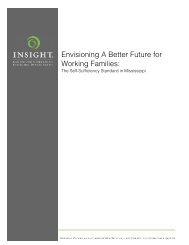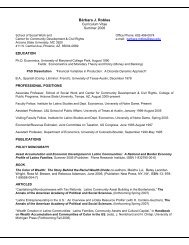Saving Patterns and Probability of Success in Individual ...
Saving Patterns and Probability of Success in Individual ...
Saving Patterns and Probability of Success in Individual ...
Create successful ePaper yourself
Turn your PDF publications into a flip-book with our unique Google optimized e-Paper software.
<strong>Sav<strong>in</strong>g</strong> <strong>Patterns</strong> <strong>and</strong> <strong>Probability</strong> <strong>of</strong> … 3<br />
1- Introduction:<br />
The importance <strong>of</strong> regularity <strong>in</strong> sav<strong>in</strong>g patterns <strong>and</strong> its effect on chang<strong>in</strong>g savers’ behaviors <strong>in</strong><br />
IDA programs is a topic that has attracted much attention <strong>in</strong> recent years. 1 This issue not only<br />
affects the design <strong>of</strong> a successful program, but also is <strong>of</strong> relevance <strong>in</strong> the analysis <strong>of</strong> program<br />
costs. While there is some level <strong>of</strong> unanimity among IDA practitioners about the importance <strong>of</strong><br />
regularity <strong>in</strong> chang<strong>in</strong>g the behavior <strong>of</strong> low-<strong>in</strong>come savers, the jury is still out on the issue <strong>of</strong> what<br />
exactly results <strong>in</strong> this change. 2<br />
Many recent studies focus on the demographic attributes <strong>of</strong> savers such as age, ethnicity, sex,<br />
<strong>and</strong> marital status <strong>and</strong> their impact on sav<strong>in</strong>gs outcomes. In a series <strong>of</strong> articles, researchers,<br />
mostly from the Center for Social Development at the University <strong>of</strong> Wash<strong>in</strong>gton <strong>in</strong> St. Louis,<br />
have studied the IDA sav<strong>in</strong>gs outcomes us<strong>in</strong>g data from the American Dream Demonstration<br />
(ADD) project <strong>in</strong> Tulsa, Oklahoma. For example, Curley <strong>and</strong> Gr<strong>in</strong>ste<strong>in</strong>-Weiss (2003), studied the<br />
rural-urban sav<strong>in</strong>gs performance <strong>and</strong> concluded that Caucasians were among the least sav<strong>in</strong>g <strong>of</strong><br />
most ethnic groups <strong>in</strong> both the rural <strong>and</strong> urban areas. In analyz<strong>in</strong>g the behavior <strong>of</strong> the microenterprise<br />
IDA savers, Ssewamala <strong>and</strong> Sherraden (2004) concluded that while level <strong>of</strong> education,<br />
<strong>in</strong>come <strong>and</strong> ownership <strong>of</strong> other assets positively <strong>in</strong>fluenced sav<strong>in</strong>gs <strong>in</strong> micro-enterprise IDAs,<br />
number <strong>of</strong> children <strong>in</strong> the household had a negative impact on sav<strong>in</strong>gs outcomes among this<br />
group. This result was partly corroborated by Gr<strong>in</strong>ste<strong>in</strong>-Weiss <strong>and</strong> Ssewamala (2005). They<br />
recognized that the cost <strong>of</strong> rais<strong>in</strong>g children was a factor that impacted sav<strong>in</strong>gs outcomes <strong>in</strong> an<br />
adverse fashion, but partly <strong>of</strong>fsett<strong>in</strong>g that hypothesis, their analysis also confirmed the relevance<br />
<strong>of</strong> the <strong>in</strong>stitutional view <strong>of</strong> sav<strong>in</strong>gs. Us<strong>in</strong>g a Hierarchical OLS regression model, they concluded<br />
that proper <strong>in</strong>stitutions led to <strong>in</strong>creased sav<strong>in</strong>gs levels even among households with children.<br />
3














